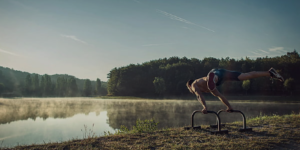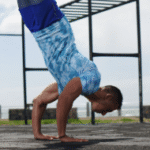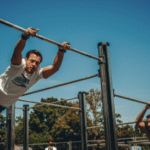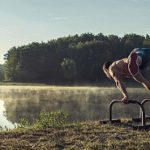10 Calisthenics Myths Busted
Calisthenics, often referred to as bodyweight training, is a powerful and versatile form of exercise that utilizes your own bodyweight as resistance to build strength, endurance, flexibility, and overall fitness. It’s a discipline that has been practiced for centuries, with roots in ancient Greece, and it continues to gain popularity today due to its accessibility, effectiveness, and ability to transform both the body and mind. Here’s a detailed exploration of calisthenics:
- The Essence of Calisthenics
Bodyweight as Resistance: Calisthenics exercises leverage your bodyweight against gravity to create resistance and challenge your muscles. By manipulating body angles, leverage, and movement variations, you can target different muscle groups and achieve a wide range of fitness goals.
Functional Movement: Calisthenics emphasizes functional movements that mimic natural human actions, such as pushing, pulling, squatting, and lunging. This focus on functional movement improves your ability to perform everyday activities and enhances your athletic performance in various sports and activities.
Progressive Overload: A key principle in calisthenics is progressive overload, where you gradually increase the difficulty of exercises as you get stronger. This can be achieved by increasing repetitions, sets, or progressing to more challenging variations of the exercises.
- Benefits of Calisthenics
Physical Benefits:
Increased muscle mass, strength, and definition
Improved flexibility, mobility, and range of motion
Enhanced cardiovascular fitness and endurance
Stronger core and improved stability
Reduced risk of injuries
Increased bone density
Mental Benefits:
Increased mental toughness, discipline, and resilience
Enhanced focus, concentration, and mindfulness
Boosted self-confidence and self-esteem
Deeper connection with your body
Reduced stress and anxiety
- Fundamental Calisthenics Exercises
Upper Body:
Pushing Movements:
Push-ups: A classic exercise that targets the chest, shoulders, and triceps.
Variations: Incline push-ups, decline push-ups, diamond push-ups, archer push-ups.
Dips: Works the chest, triceps, and shoulders, with variations emphasizing different muscle groups.
Pulling Movements:
Pull-ups: Targets the back, biceps, and forearms, developing pulling strength.
Variations: Chin-ups, wide-grip pull-ups, close-grip pull-ups.
Rows: Works the back muscles from a horizontal position, improving posture and strength.
Variations: Inverted rows, Australian pull-ups.
Lower Body:
Squats: A fundamental movement that strengthens the quads, hamstrings, and glutes.
Variations: Jump squats, pistol squats, Bulgarian split squats.
Lunges: Targets the quads, hamstrings, and glutes, improving single-leg strength and balance.
Variations: Forward lunges, reverse lunges, walking lunges.
Core:
Plank: A static hold that strengthens the entire core, improving stability and posture.
Variations: Forearm plank, high plank, side plank.
Hollow Body Hold: Engages the core muscles, improving core control and strength.
Leg Raises: Works the lower abdominals, contributing to a strong and defined core.
Variations: Hanging leg raises, lying leg raises.
- Advanced Calisthenics Skills
Handstand: A fundamental skill that requires balance, upper body strength, and core stability.
Variations: Handstand push-ups, handstand walks.
Muscle-Up: A dynamic movement that combines a pull-up and a dip, requiring explosive pulling strength.
Variations: Bar muscle-ups, ring muscle-ups.
Front Lever: A static hold where the body is suspended horizontally from a bar, parallel to the ground.
Planche: A static hold where the body is suspended horizontally above the ground, supported only by the hands.
Human Flag: A visually impressive skill where the body is held horizontally, resembling a flag, using a vertical pole or bar.
- Training Principles
Progressive Overload: Gradually increase the difficulty of exercises as you get stronger.
Consistency: Train regularly, aiming for at least 2-3 workouts per week.
Proper Form: Focus on maintaining proper form to prevent injuries and maximize results.
Rest and Recovery: Allow adequate rest between workouts for muscle repair and growth.
Nutrition: Support your training with a healthy diet that provides essential nutrients.
- Calisthenics and the Mind
Mental Toughness: Overcoming challenging exercises builds mental resilience and discipline.
Focus and Concentration: Calisthenics requires focus and concentration, which can translate to other areas of life.
Mind-Body Connection: The emphasis on body control and awareness fosters a deeper connection between the mind and body.
- The Calisthenics Community
Support and Motivation: Connect with other calisthenics enthusiasts online or offline for support, motivation, and shared learning.
Inspiration: Find inspiration from experienced calisthenics athletes and their achievements.
Collective Growth: The calisthenics community is constantly pushing the boundaries of what’s possible with bodyweight training.
Calisthenics is more than just a workout; it’s a journey of self-improvement, discipline, and mastery over your own body. By embracing the challenges, practicing with dedication, and connecting with the community, you can unlock your full potential and achieve extraordinary feats of strength, skill, and grace. So, embark on your calisthenics journey today and discover the transformative power of bodyweight training.

10 Calisthenics Myths Busted
Route
Calisthenics Gym Houston Functional Bodyweight Training
Secondary phone: (346) 483-3195
Email: info@calisthenicsclubhouston.com
URL: https://calisthenicsclubhouston.com/
Monday 6:00 AM - 7:00 PM Tuesday 6:00 AM - 7:00 PM Wednesday 6:00 AM - 7:00 PM Thursday 6:00 AM - 7:00 PM Friday 12:00 PM - 6:30 PM Saturday 9:45 AM - 12:00 PM Sunday 3:00 PM - 5:00 PM





